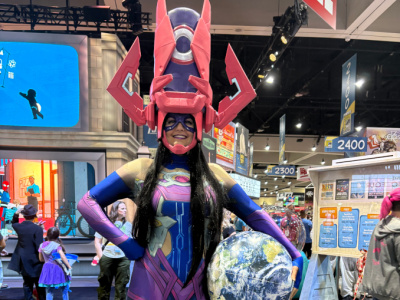
ICv2 recently spoke with Gonzalo Ferreyra, Viz Media Vice President of Sales and Product Marketing, to get his views on the state of the manga and anime markets and their trends. In Part Two, of this four part interview, we talk about the widening sales gap between top and other manga titles, Viz’s plans for OEL projects, the changing demographics of manga readers, Borders' role in the manga market, over-all anime DVD market trends, and the state of anime on TV in the States. In Part Three, we talk about the widening sales gap between top and other anime titles, the mainstreaming of anime, and trends in online delivery of anime and manga. In Part Four, we talk about Viz Pictures, anime time lags, and some of the company's most exciting release plans for 2009, including a new science fiction publishing imprint. In Part 1, we talk about the over-all manga market, changes by channel, and the evaluation a year later of the “Naruto Nation” release surge.
We’ve heard that there is more attention at both the consumer and trade level to the top manga titles while the middle and bottom titles are losing audience. Viz is blessed to have a lot of titles in that top tier, but between the various titles you offer, do you see that trend?
We’re not seeing it as much. It’s a question of expectation, and we’ve always been rather realistic about understanding the potential of that middle and bottom tier, so to speak. We’ve also done a little bit of housecleaning to manage the list and help us focus our list a bit more. But I wouldn’t say that we’re seeing a dramatic difference in the response to the long tail.
We were surprised about the announcement that Viz is running portfolio reviews with a eye toward publishing OEL titles in the States. Can you give us an update on where that initiative is?
It’s still in the early stages. It’s spearheaded by Marc Wiedenbaum, who is in charge of the division we’re calling Original Content. They’re moving ahead with portfolio reviews, laying out their strategy for the Original Content Group currently.
We did a story on VizKids in August (see “VizKids Growing Up”). Can you tell us about where you think the demographics of manga readership is? This seems to be an effort to take it younger or introduce readers at a younger age. How do you see the over-all demographics vs. a year ago?
This is a subject very close to my heart because it’s extremely exciting for us right now. The VizKids initiative is just one component of a real effort initiated a year to a year-and-a-half ago by Alvin Lu, our VP of Production, who at that point proposed that we move forward with an expansion and positioning of ourselves as a “publisher.” And what I mean by that is first and foremost a publisher, not a manga publisher, not a graphic novel publisher, but a publisher at large with a wide range of focuses and interests.
Obviously we want to stay close to home on the front end here, and where we’re going first is an expansion of what manga currently is in the American market. We know from looking at the list, it’s still by and large seen as a tween demographic--boys and girls--and that leaves out a tremendous range of fabulous content that is available in
That’s one piece of it and on the older side you’ve got seinen; you’ve got our Signature Line which is key to growth of another kind; which is, where these kids are going to go as they mature, as they hit college and leave college, what are they going to be reading? I’d like to believe that readers of Watchmen should be reading selected titles in the Signature series. It’s a very strong equivalent and that’s what we want to get to. We’ve been pushing on both fronts this year.
According to most, Borders (which has been getting a lot of press lately) is the largest retailer of manga in the country. In the last quarterly report their CEO said that efforts to cut inventory may have gone past cutting fat and they’ve been hitting meat or bone. What do you see as the current impact of Borders on the manga business over-all and is their role in the manga business changing?
We keep a pretty close eye on the market in general, both within graphic novels and manga and outside, and generally speaking I’m pleased to report that we’ve remained ahead of the curve. We have really not experienced the downturn that we frequently hear about and the challenges that we hear about. Of course we’re cognizant of them [Borders]; their importance as an account to us remains unchanged, and if anything is maybe stronger in some respects. I know it’s happening and fortunately we’ve been relatively immune (knock on wood) this past year.
Switching over to anime: what’s your over-all view of the anime/DVD business in the States this year?
DVDs also saw strong growth this year. Again we’ve been fortunate to have wonderful relationships with big box retailers; we have launched a DTO [download-to-own] initiative this year as well. We have several series currently available--Naruto, Bleach, and Death Note--with more to come available through DTO.
We continue to see very strong growth across the board. We watch it very closely and we expect significant changes in the next two or three years. We’re not entirely sure what those changes will be, but for the time being, the folks are still picking up the DVD and we’re worked very consistently on improving our packaging, taking harder looks at our price points, repackaging, and those efforts have been very successful. We’ve launched a boxed set program lead by Naruto, no surprise there, which has been tremendous for us and we’re well into the Naruto Uncut Boxed Sets. And those, to our amazement, are attracting a very widespread audience.
There seem to be some changes, incremental but ongoing, in the places that anime is shown on television. In particular Cartoon Network seems to be cutting back, some other channels seem to be increasing, although it’s unclear if the same rating points are out there. What’s your perspective on the exposure of anime on television--do you think that’s increasing, decreasing, staying about the same?
It seems to be staying about the same, all things considered. We’ll have to watch in the next couple of years where that goes. Clearly there’s a lot of original programming that a lot of these broadcasters are bringing on board. There’s still consistent support of anime through traditional broadcasts and of course we’re looking very closely at streaming and other mediums. There are significant players right now online that will provide viewing options for fans out there and we hope to work closely with all of them.







